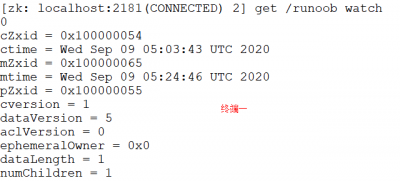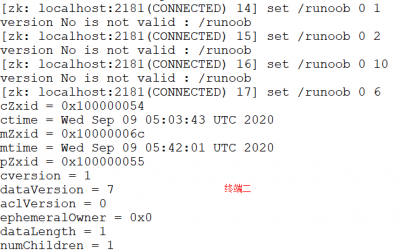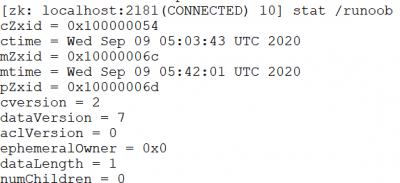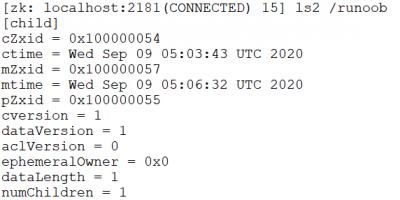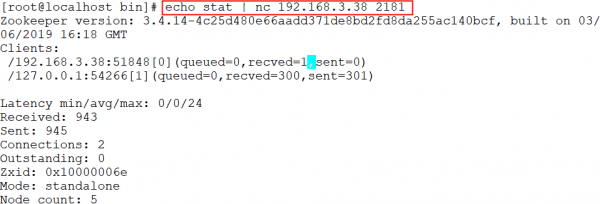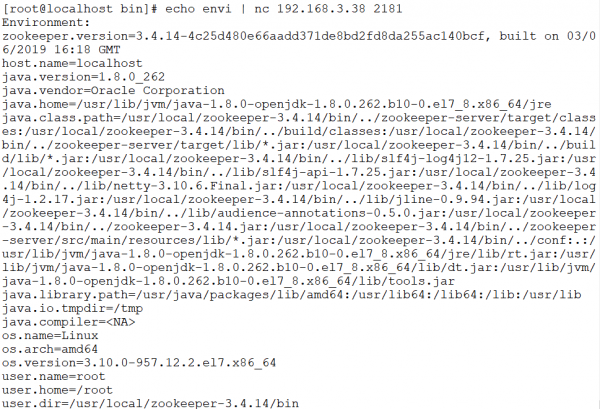“Zookeeper:命令行(CLI)”的版本间差异
| 第578行: | 第578行: | ||
=== Curator === | === Curator === | ||
---- | |||
Curator 是 Netflix 公司开源的一套 zookeeper 客户端框架,解决了很多 Zookeeper 客户端非常底层的细节开发工作,包括连接重连、反复注册 Watcher 和 NodeExistsException 异常等。 | |||
* curator 相关参考链接:[http://curator.apache.org/ http://curator.apache.org/]。 | |||
Curator 包含了几个包: | |||
* '''curator-framework''':对 zookeeper 的底层 api 的一些封装。 | |||
* '''curator-client''':提供一些客户端的操作,例如重试策略等。 | |||
* '''curator-recipes''':封装了一些高级特性,如:Cache 事件监听、选举、分布式锁、分布式计数器、分布式 Barrier 等。【!!!】 | |||
示例: | |||
: <syntaxhighlight lang="java" highlight=""> | |||
public class CuratorDemo { | |||
public static void main(String[] args) throws Exception { | |||
<syntaxhighlight lang="java" highlight=""> | CuratorFramework curatorFramework = CuratorFrameworkFactory. | ||
builder().connectString("192.168.3.33:2181," + | |||
"192.168.3.35:2181,192.168.3.37:2181"). | |||
sessionTimeoutMs(4000).retryPolicy(new | |||
ExponentialBackoffRetry(1000,3)). | |||
namespace("").build(); | |||
curatorFramework.start(); | |||
Stat stat=new Stat(); | |||
//查询节点数据 | |||
byte[] bytes = curatorFramework.getData().storingStatIn(stat).forPath("/runoob"); | |||
System.out.println(new String(bytes)); | |||
curatorFramework.close(); | |||
} | |||
} | |||
</syntaxhighlight> | </syntaxhighlight> | ||
: 上一步设置了 /runoob 节点值,所以控制台输出。 | |||
: [[File:Zookeeper:Java客户端:Curator示例.png|800px]] | |||
2021年5月15日 (六) 01:07的版本
命令行界面(CLI)
ZooKeeper 命令行界面(CLI)用于与ZooKeeper集合进行交互以进行开发。它有助于调试和解决不同的选项。
- 要执行ZooKeeper CLI操作,首先打开ZooKeeper服务器(“bin/zkServer.sh start”),然后打开ZooKeeper客户端(“bin/zkCli.sh”)。
CLI 常用命令:
- create:创建节点并赋值。
create [-s] [-e] path data acl
- [-s] [-e]:-s 代表顺序节点,-e 代表临时节点,二者可以同时使用的,并且临时节点不能再创建子节点。
- path:指定要创建节点的路径,比如 /runoob。
- data:要在此节点存储的数据。
- acl:访问权限相关,默认是 world:开放式权限(所有都可以访问)。
- get:获取节点数据和状态信息。
get path [watch]
- path:代表路径。
- [watch]:对节点进行事件监听。
- set:修改节点存储的数据。
set path data [version]
- path:节点路径。
- data:需要存储的数据。
- [version]:可选项,版本号(可用作乐观锁)。【只有版本号正确操作才能成功】
- stat:查看节点状态信息。
stat path [watch]
- path:代表路径。
- [watch]:对节点进行事件监听。
- delete:删除某节点(包括其子节点)。
delete path [version]
- path:节点路径。
- [version]:可选项,版本号(同 set 命令)。
- rmr:删除某节点(只能删除不含子节点的节点)。
rmr path [version]
- path:节点路径。
- [version]:可选项,版本号(同 set 命令)。
- ls:查看某个路径下目录列表。
ls path
- path:代表路径。
- ls2:查看某个路径下目录列表。(比 ls 命令列出更多的详细信息)
ls2 path
- path:代表路径。
四字命令【???】
zookeeper 支持某些特定的四字命令与其交互,用户获取 zookeeper 服务的当前状态及相关信息,用户在客户端可以通过 telenet 或者 nc(netcat) 向 zookeeper 提交相应的命令。
安装 nc 命令:
$ yum install nc # centos
或
$ sudo apt install netcat # ubuntu
四字命令格式:
echo [command] | nc [ip] [port]
ZooKeeper 常用四字命令主要如下:
| 命令 | 描述 |
|---|---|
| conf | 3.3.0版本引入。打印出服务相关配置的详细信息。 |
| cons | 3.3.0版本引入。列出所有连接到这台服务器的客户端全部连接/会话详细信息。包括"接受/发送"的包数量、会话id、操作延迟、最后的操作执行等等信息。 |
| crst | 3.3.0版本引入。重置所有连接的连接和会话统计信息。 |
| dump | 列出那些比较重要的会话和临时节点。这个命令只能在leader节点上有用。 |
| envi | 打印出服务环境的详细信息。 |
| reqs | 列出未经处理的请求 |
| ruok | 测试服务是否处于正确状态。如果确实如此,那么服务返回"imok",否则不做任何相应。 |
| stat | 输出关于性能和连接的客户端的列表。 |
| srst | 重置服务器的统计。 |
| srvr | 3.3.0版本引入。列出连接服务器的详细信息 |
| wchs | 3.3.0版本引入。列出服务器watch的详细信息。 |
| wchc | 3.3.0版本引入。通过session列出服务器watch的详细信息,它的输出是一个与watch相关的会话的列表。 |
| wchp | 3.3.0版本引入。通过路径列出服务器watch的详细信息。它输出一个与session相关的路径。 |
| mntr | 3.4.0版本引入。输出可用于检测集群健康状态的变量列表 |
使用:
- stat命令:用于查看 zk 的状态信息,实例如下:
- ruok命令:用于查看当前 zkserver 是否启动,若返回 imok 表示正常。实例如下:
- dump命令:用于列出未经处理的会话和临时节点。实例如下:
- conf命令:用于查看服务器配置。实例如下:
- cons命令:用于展示连接到服务器的客户端信息。实例如下:
- envi命令:用于查看环境变量。实例如下:
Java客户端
Java 客户端包括两种方式:
- 原生 API;
- Curator;
Java 客户端搭建
使用的 IDE 为 IntelliJ IDEA,创建一个 maven 工程,命名为 zookeeper-demo,并且引入如下依赖,可以自行在maven中央仓库选择合适的版本:
<dependency>
<groupId>junit</groupId>
<artifactId>junit</artifactId>
<version>4.11</version>
<scope>test</scope>
</dependency>
<dependency>
<groupId>org.apache.zookeeper</groupId>
<artifactId>zookeeper</artifactId>
<version>3.4.8</version>
</dependency>
<dependency>
<groupId>org.apache.curator</groupId>
<artifactId>curator-framework</artifactId>
<version>4.0.0</version>
</dependency>
<dependency>
<groupId>org.apache.curator</groupId>
<artifactId>curator-recipes</artifactId>
<version>4.0.0</version>
</dependency>
maven 工程目录结构:
原生 API(Zookeeper API)
ZooKeeper 有一个绑定 Java 和 C 的官方API。Zookeeper 社区为大多数语言(.NET,python等)提供非官方API。
使用ZooKeeper API,应用程序可以连接,交互,操作数据,协调,最后断开与ZooKeeper集合的连接。
- ZooKeeper API具有丰富的功能,以简单和安全的方式获得ZooKeeper集合的所有功能。
- ZooKeeper API提供同步和异步方法。
ZooKeeper集合和ZooKeeper API在各个方面都完全相辅相成,对开发人员有很大的帮助。
ZooKeeper API的基础知识
与ZooKeeper集合进行交互的应用程序称为 ZooKeeper客户端或简称客户端。
- Znode 是ZooKeeper集合的核心组件,ZooKeeper API提供了一小组方法使用ZooKeeper集合来操纵znode的所有细节。
客户端应该遵循以步骤,与ZooKeeper集合进行清晰和干净的交互:
- 连接到ZooKeeper集合。ZooKeeper集合为客户端分配会话ID。
- 定期向服务器发送心跳。否则,ZooKeeper集合将过期会话ID,客户端需要重新连接。
- 只要会话ID处于活动状态,就可以获取/设置znode。
- 所有任务完成后,断开与ZooKeeper集合的连接。如果客户端长时间不活动,则ZooKeeper集合将自动断开客户端。
org.apache.zookeeper.ZooKeeper
ZooKeeper API的核心部分是ZooKeeper类。它提供了在其构造函数中连接ZooKeeper集合的选项,并具有以下方法:
- connect:连接到 ZooKeeper集合;
- create:创建 znode;
- exists:检查 znode 是否存在及其信息;
- getData:从特定的 znode 获取数据;
- setData:在特定的 znode 中设置数据;
- getChildren:获取特定 znode 中的所有子节点;
- delete:删除特定的 znode 及其所有子项;
- close:关闭连接;
示例:
- 连接到 ZooKeeper 集合:
- ZooKeeper 类通过其构造函数提供connect功能。构造函数的签名如下 :
ZooKeeper(String connectionString, int sessionTimeout, Watcher watcher)
- connectionString - ZooKeeper集合主机。
- sessionTimeout - 会话超时(以毫秒为单位)。
- watcher - 实现“监视器”界面的对象。ZooKeeper集合通过监视器对象返回连接状态。
// import java classes import java.io.IOException; import java.util.concurrent.CountDownLatch; // import zookeeper classes import org.apache.zookeeper.KeeperException; import org.apache.zookeeper.WatchedEvent; import org.apache.zookeeper.Watcher; import org.apache.zookeeper.Watcher.Event.KeeperState; import org.apache.zookeeper.ZooKeeper; import org.apache.zookeeper.AsyncCallback.StatCallback; import org.apache.zookeeper.KeeperException.Code; import org.apache.zookeeper.data.Stat; public class ZooKeeperConnection { // declare zookeeper instance to access ZooKeeper ensemble private ZooKeeper zoo; final CountDownLatch connectedSignal = new CountDownLatch(1); // Method to connect zookeeper ensemble. public ZooKeeper connect(String host) throws IOException,InterruptedException { zoo = new ZooKeeper(host,5000,new Watcher() { public void process(WatchedEvent we) { if (we.getState() == KeeperState.SyncConnected) { connectedSignal.countDown(); } } }); connectedSignal.await(); return zoo; } // Method to disconnect from zookeeper server public void close() throws InterruptedException { zoo.close(); } }
- create 方法:
- ZooKeeper类提供了在ZooKeeper集合中创建一个新的 znode 的 create 方法。create 方法的签名如下:
create(String path, byte[] data, List<ACL> acl, CreateMode createMode)
- path - Znode 路径。例如,/myapp1,/myapp2,/myapp1/mydata1,myapp2/mydata1/myanothersubdata
- data - 要存储在指定 znode 路径中的数据
- acl - 要创建的节点的访问控制列表。ZooKeeper API提供了一个静态接口 ZooDefs.Ids 来获取一些基本的acl列表。例如,ZooDefs.Ids.OPEN_ACL_UNSAFE返回打开znode的acl列表。
- createMode - 节点的类型,即临时,顺序或两者。这是一个枚举。
import java.io.IOException; import org.apache.zookeeper.WatchedEvent; import org.apache.zookeeper.Watcher; import org.apache.zookeeper.Watcher.Event.KeeperState; import org.apache.zookeeper.ZooKeeper; import org.apache.zookeeper.KeeperException; import org.apache.zookeeper.CreateMode; import org.apache.zookeeper.ZooDefs; public class ZKCreate { // create static instance for zookeeper class. private static ZooKeeper zk; // create static instance for ZooKeeperConnection class. private static ZooKeeperConnection conn; // Method to create znode in zookeeper ensemble public static void create(String path, byte[] data) throws KeeperException,InterruptedException { zk.create(path, data, ZooDefs.Ids.OPEN_ACL_UNSAFE, CreateMode.PERSISTENT); } public static void main(String[] args) { // znode path String path = "/MyFirstZnode"; // Assign path to znode // data in byte array byte[] data = "My first zookeeper app".getBytes(); // Declare data try { conn = new ZooKeeperConnection(); zk = conn.connect("localhost"); create(path, data); // Create the data to the specified path conn.close(); } catch (Exception e) { System.out.println(e.getMessage()); //Catch error message } } }
- exists 方法:
- ZooKeeper类提供了 exists 方法来检查znode的存在。如果指定的znode存在,则返回一个znode的元数据(Stat)。exists 方法的签名如下:
exists(String path, boolean watcher)
- path- Znode路径
- watcher - 布尔值,用于指定是否监视指定的 znode
import java.io.IOException; import org.apache.zookeeper.ZooKeeper; import org.apache.zookeeper.KeeperException; import org.apache.zookeeper.WatchedEvent; import org.apache.zookeeper.Watcher; import org.apache.zookeeper.Watcher.Event.KeeperState; import org.apache.zookeeper.data.Stat; public class ZKExists { private static ZooKeeper zk; private static ZooKeeperConnection conn; // Method to check existence of znode and its status, if znode is available. public static Stat znode_exists(String path) throws KeeperException,InterruptedException { return zk.exists(path, true); } public static void main(String[] args) throws InterruptedException,KeeperException { String path = "/MyFirstZnode"; // Assign znode to the specified path try { conn = new ZooKeeperConnection(); zk = conn.connect("localhost"); Stat stat = znode_exists(path); // Stat checks the path of the znode if(stat != null) { System.out.println("Node exists and the node version is " + stat.getVersion()); } else { System.out.println("Node does not exists"); } } catch(Exception e) { System.out.println(e.getMessage()); // Catches error messages } } }
Node exists and the node version is 1.
- getData 方法:
- ZooKeeper类提供 getData 方法来获取附加在指定znode中的数据及其状态。 getData 方法的签名如下:
getData(String path, Watcher watcher, Stat stat)
- path - Znode路径。
- watcher - 监视器类型的回调函数。当指定的znode的数据改变时,ZooKeeper集合将通过监视器回调进行通知。这是一次性通知。
- stat - 返回znode的元数据。
import java.io.IOException; import java.util.concurrent.CountDownLatch; import org.apache.zookeeper.ZooKeeper; import org.apache.zookeeper.KeeperException; import org.apache.zookeeper.WatchedEvent; import org.apache.zookeeper.Watcher; import org.apache.zookeeper.Watcher.Event.KeeperState; import org.apache.zookeeper.data.Stat; public class ZKGetData { private static ZooKeeper zk; private static ZooKeeperConnection conn; public static Stat znode_exists(String path) throws KeeperException,InterruptedException { return zk.exists(path,true); } public static void main(String[] args) throws InterruptedException, KeeperException { String path = "/MyFirstZnode"; final CountDownLatch connectedSignal = new CountDownLatch(1); try { conn = new ZooKeeperConnection(); zk = conn.connect("localhost"); Stat stat = znode_exists(path); if(stat != null) { byte[] b = zk.getData(path, new Watcher() { public void process(WatchedEvent we) { if (we.getType() == Event.EventType.None) { switch(we.getState()) { case Expired: connectedSignal.countDown(); break; } } else { String path = "/MyFirstZnode"; try { byte[] bn = zk.getData(path, false, null); String data = new String(bn, "UTF-8"); System.out.println(data); connectedSignal.countDown(); } catch(Exception ex) { System.out.println(ex.getMessage()); } } } }, null); String data = new String(b, "UTF-8"); System.out.println(data); connectedSignal.await(); } else { System.out.println("Node does not exists"); } } catch(Exception e) { System.out.println(e.getMessage()); } } }
- setData 方法:
- ZooKeeper类提供 setData 方法来修改指定znode中附加的数据。 setData 方法的签名如下:
setData(String path, byte[] data, int version)
- path- Znode路径
- data - 要存储在指定znode路径中的数据。
- version- znode的当前版本。每当数据更改时,ZooKeeper会更新znode的版本号。
import org.apache.zookeeper.ZooKeeper; import org.apache.zookeeper.KeeperException; import org.apache.zookeeper.WatchedEvent; import org.apache.zookeeper.Watcher; import org.apache.zookeeper.Watcher.Event.KeeperState; import java.io.IOException; public class ZKSetData { private static ZooKeeper zk; private static ZooKeeperConnection conn; // Method to update the data in a znode. Similar to getData but without watcher. public static void update(String path, byte[] data) throws KeeperException,InterruptedException { zk.setData(path, data, zk.exists(path,true).getVersion()); } public static void main(String[] args) throws InterruptedException,KeeperException { String path= "/MyFirstZnode"; byte[] data = "Success".getBytes(); //Assign data which is to be updated. try { conn = new ZooKeeperConnection(); zk = conn.connect("localhost"); update(path, data); // Update znode data to the specified path } catch(Exception e) { System.out.println(e.getMessage()); } } }
- getChildren 方法:
- ZooKeeper类提供 getChildren 方法来获取特定znode的所有子节点。 getChildren 方法的签名如下:
getChildren(String path, Watcher watcher)
- path - Znode路径。
- watcher - 监视器类型的回调函数。当指定的znode被删除或znode下的子节点被创建/删除时,ZooKeeper集合将进行通知。这是一次性通知。
import java.io.IOException; import java.util.*; import org.apache.zookeeper.ZooKeeper; import org.apache.zookeeper.KeeperException; import org.apache.zookeeper.WatchedEvent; import org.apache.zookeeper.Watcher; import org.apache.zookeeper.Watcher.Event.KeeperState; import org.apache.zookeeper.data.Stat; public class ZKGetChildren { private static ZooKeeper zk; private static ZooKeeperConnection conn; // Method to check existence of znode and its status, if znode is available. public static Stat znode_exists(String path) throws KeeperException,InterruptedException { return zk.exists(path,true); } public static void main(String[] args) throws InterruptedException,KeeperException { String path = "/MyFirstZnode"; // Assign path to the znode try { conn = new ZooKeeperConnection(); zk = conn.connect("localhost"); Stat stat = znode_exists(path); // Stat checks the path if(stat!= null) { //“getChildren" method- get all the children of znode.It has two args, path and watch List <String> children = zk.getChildren(path, false); for(int i = 0; i < children.size(); i++) System.out.println(children.get(i)); //Print children's } else { System.out.println("Node does not exists"); } } catch(Exception e) { System.out.println(e.getMessage()); } } }
- delete 方法:
- ZooKeeper类提供了 delete 方法来删除指定的znode。 delete 方法的签名如下:
delete(String path, int version)
- path - Znode路径。
- version - znode的当前版本。
import org.apache.zookeeper.ZooKeeper; import org.apache.zookeeper.KeeperException; public class ZKDelete { private static ZooKeeper zk; private static ZooKeeperConnection conn; // Method to check existence of znode and its status, if znode is available. public static void delete(String path) throws KeeperException,InterruptedException { zk.delete(path,zk.exists(path,true).getVersion()); } public static void main(String[] args) throws InterruptedException,KeeperException { String path = "/MyFirstZnode"; //Assign path to the znode try { conn = new ZooKeeperConnection(); zk = conn.connect("localhost"); delete(path); //delete the node with the specified path } catch(Exception e) { System.out.println(e.getMessage()); // catches error messages } } }
Curator
Curator 是 Netflix 公司开源的一套 zookeeper 客户端框架,解决了很多 Zookeeper 客户端非常底层的细节开发工作,包括连接重连、反复注册 Watcher 和 NodeExistsException 异常等。
- curator 相关参考链接:http://curator.apache.org/。
Curator 包含了几个包:
- curator-framework:对 zookeeper 的底层 api 的一些封装。
- curator-client:提供一些客户端的操作,例如重试策略等。
- curator-recipes:封装了一些高级特性,如:Cache 事件监听、选举、分布式锁、分布式计数器、分布式 Barrier 等。【!!!】
示例:
public class CuratorDemo { public static void main(String[] args) throws Exception { CuratorFramework curatorFramework = CuratorFrameworkFactory. builder().connectString("192.168.3.33:2181," + "192.168.3.35:2181,192.168.3.37:2181"). sessionTimeoutMs(4000).retryPolicy(new ExponentialBackoffRetry(1000,3)). namespace("").build(); curatorFramework.start(); Stat stat=new Stat(); //查询节点数据 byte[] bytes = curatorFramework.getData().storingStatIn(stat).forPath("/runoob"); System.out.println(new String(bytes)); curatorFramework.close(); } }
- 上一步设置了 /runoob 节点值,所以控制台输出。
- 文件:Zookeeper:Java客户端:Curator示例.png

